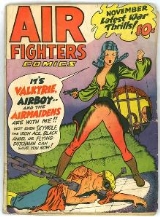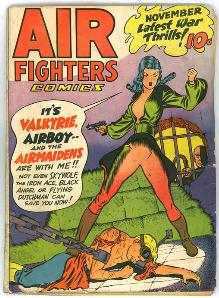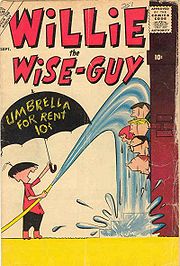
Fred Kida
Encyclopedia
Fred Kida is an American
comic book
and comic strip
artist
best known for the characters Airboy
and Valkyrie.
, Kida attended New York City's American School of Design, where Bill Fraccio
and Bob Fujitani were classmates. Like many young artists in the Golden Age of comic books
, he then broke into the field at the Jerry Iger Studio
, formerly Eisner & Iger
, one of the earliest "packagers" that produced outsourced comic book content for publishers entering the new medium
. Starting as an inker
and background artist in 1941, Kida moved on to a staff position at Iger client Quality Comics
. There he both penciled and inked his first known credited work, the feature "Phantom Clipper" in Military Comics #9 (April 1942).

, where he drew such features as "Iron Ace" (from its premiere in Air Fighters Comics vol. 1, #2, Nov. 1942), "Boy King" and "Gunmaster", and the following year began work on his most prominent Golden Age character, Airboy
. That aviation hero, created by writer Charles Biro
with scripter Dick Wood
and artist Al Camy, appeared initially in Air Fighters Comics, later renamed Airboy Comics. Aside from Airboy himself, the feature was known for the sexy antagonist the Valkyrie, a cleavage-baring Axis
aviatrix who soon defected and became his ally.
 Kida remained on the feature through 1948, afterward working with writer Biro on such Hillman crime comics as the seminal Crime Does Not Pay. In 1953, he left to freelance for Atlas Comics
Kida remained on the feature through 1948, afterward working with writer Biro on such Hillman crime comics as the seminal Crime Does Not Pay. In 1953, he left to freelance for Atlas Comics
, the 1950s forerunner of Marvel Comics
. There he worked on characters including the Western
gunslingers the Ringo Kid
and the Two-Gun Kid
and the medieval hero the Black Knight
, plus horror
, war
and Bible stories.
Kida returned to Marvel in the 1970s, primarily as an inker, working on such characters as Iron Man
, Godzilla
, Ka-Zar
, Luke Cage
and Man-Wolf, plus Captain Britain
for Marvel UK
. His final known full comic-book credit is the superhero-team title The Defenders
#72 (June 1979) — featuring Marvel's Valkyrie. His last known published comic-book work was in the 1980s Eclipse Comics
revamp of Airboy, to which he contributed a full-page pinup featuring both Airboy and Valkyrie.
's assistants on the newspaper
Sunday-supplement comic-book The Spirit
; and from 1946-47 assisted Fujitani (also known as "Bob Wells") on the comic strip Judge Wright. He also briefly assisted Milton Caniff
on the strip Steve Canyon
.
Most notably, Kida assisted artist
Dan Barry on the long-running strip Flash Gordon
from 1958–61 and then again from 1968–71; and under his own byline, he drew the comic strip The Amazing Spider-Man during the early to mid-1980s.
United States
The United States of America is a federal constitutional republic comprising fifty states and a federal district...
comic book
Comic book
A comic book or comicbook is a magazine made up of comics, narrative artwork in the form of separate panels that represent individual scenes, often accompanied by dialog as well as including...
and comic strip
Comic strip
A comic strip is a sequence of drawings arranged in interrelated panels to display brief humor or form a narrative, often serialized, with text in balloons and captions....
artist
Artist
An artist is a person engaged in one or more of any of a broad spectrum of activities related to creating art, practicing the arts and/or demonstrating an art. The common usage in both everyday speech and academic discourse is a practitioner in the visual arts only...
best known for the characters Airboy
Airboy
Airboy is a fictional aviator hero of an American comic book series initially published by Hillman Periodicals during the World War II-era time period fans and historians call the Golden Age of comic books. He was created by writers Charles Biro and Dick Wood and artist Al Camy.-Golden Age:Airboy...
and Valkyrie.
Early life and career
Born and raised in ManhattanManhattan
Manhattan is the oldest and the most densely populated of the five boroughs of New York City. Located primarily on the island of Manhattan at the mouth of the Hudson River, the boundaries of the borough are identical to those of New York County, an original county of the state of New York...
, Kida attended New York City's American School of Design, where Bill Fraccio
Bill Fraccio
William Fraccio was an American comic book artist whose career stretched from the 1940s Golden Age of comic books through 1979, when he turned to producing advertising art and teaching...
and Bob Fujitani were classmates. Like many young artists in the Golden Age of comic books
Golden Age of Comic Books
The Golden Age of Comic Books was a period in the history of American comic books, generally thought of as lasting from the late 1930s until the late 1940s or early 1950s...
, he then broke into the field at the Jerry Iger Studio
Jerry Iger
Samuel Maxwell "Jerry" Iger was an American cartoonist. With business partner Will Eisner he co-founder of Eisner & Iger, a comic book packager that produced comics on demand for new publishers during the late-1930s and 1940s period known to fans and historians as the Golden Age of Comic...
, formerly Eisner & Iger
Eisner & Iger
Eisner & Iger was a comic book "packager" that produced comics on demand for publishers entering the new medium during the late-1930s and 1940s period fans and historians call the Golden Age of Comic Books...
, one of the earliest "packagers" that produced outsourced comic book content for publishers entering the new medium
Mass media
Mass media refers collectively to all media technologies which are intended to reach a large audience via mass communication. Broadcast media transmit their information electronically and comprise of television, film and radio, movies, CDs, DVDs and some other gadgets like cameras or video consoles...
. Starting as an inker
Inker
The inker is one of the two line artists in a traditional comic book or graphic novel. After a pencilled drawing is given to the inker, the inker uses black ink to produce refined outlines over the pencil lines...
and background artist in 1941, Kida moved on to a staff position at Iger client Quality Comics
Quality Comics
Quality Comics was an American comic book publishing company that operated from 1939 to 1956 and was an influential creative force in what historians and fans call the Golden Age of comic books....
. There he both penciled and inked his first known credited work, the feature "Phantom Clipper" in Military Comics #9 (April 1942).

Airboy and afterward
In 1942, he joined Hillman PeriodicalsHillman Periodicals
Hillman Periodicals, Inc. was an American magazine and comic book publishing company founded in 1938 by Alex L. Hillman, a former New York City book publisher...
, where he drew such features as "Iron Ace" (from its premiere in Air Fighters Comics vol. 1, #2, Nov. 1942), "Boy King" and "Gunmaster", and the following year began work on his most prominent Golden Age character, Airboy
Airboy
Airboy is a fictional aviator hero of an American comic book series initially published by Hillman Periodicals during the World War II-era time period fans and historians call the Golden Age of comic books. He was created by writers Charles Biro and Dick Wood and artist Al Camy.-Golden Age:Airboy...
. That aviation hero, created by writer Charles Biro
Charles Biro
Charles Biro was an American comic book creator and cartoonist. He is today chiefly known for creating the comic book characters Airboy and Steel Sterling, and for his 16-year run on the acclaimed 1940s series Daredevil Comics for Lev Gleason Publications.-Biography:Charles Biro studied art at...
with scripter Dick Wood
Dick Wood
Malcom Richard "Dick" Wood is a former American football quarterback who played at Auburn before being drafted by the NFL Baltimore Colts in 1959...
and artist Al Camy, appeared initially in Air Fighters Comics, later renamed Airboy Comics. Aside from Airboy himself, the feature was known for the sexy antagonist the Valkyrie, a cleavage-baring Axis
Axis Powers
The Axis powers , also known as the Axis alliance, Axis nations, Axis countries, or just the Axis, was an alignment of great powers during the mid-20th century that fought World War II against the Allies. It began in 1936 with treaties of friendship between Germany and Italy and between Germany and...
aviatrix who soon defected and became his ally.

Atlas Comics (1950s)
Atlas Comics is the term used to describe the 1950s comic book publishing company that would evolve into Marvel Comics. Magazine and paperback novel publisher Martin Goodman, whose business strategy involved having a multitude of corporate entities, used Atlas as the umbrella name for his comic...
, the 1950s forerunner of Marvel Comics
Marvel Comics
Marvel Worldwide, Inc., commonly referred to as Marvel Comics and formerly Marvel Publishing, Inc. and Marvel Comics Group, is an American company that publishes comic books and related media...
. There he worked on characters including the Western
Western comics
Western comics is a comics genre usually depicting the American Old West frontier and typically set during the late nineteenth century...
gunslingers the Ringo Kid
Ringo Kid
The Ringo Kid is a fictional Western hero in the Marvel Comics' universe, whose comic book series was originally released by the company's 1950s predecessor, Atlas Comics...
and the Two-Gun Kid
Two-Gun Kid
The Two-Gun Kid is a fictional character, a cowboy gunslinger in the Wild West of Marvel Comics' shared universe, the Marvel Universe.-Publication history:...
and the medieval hero the Black Knight
Black Knight (Sir Percy)
Sir Percy of Scandia, also known as the original Black Knight, is a fictional character in the Marvel Universe. He was a medieval knight created by writer-editor Stan Lee and artist Joe Maneely.- Publication history :...
, plus horror
Horror fiction
Horror fiction also Horror fantasy is a philosophy of literature, which is intended to, or has the capacity to frighten its readers, inducing feelings of horror and terror. It creates an eerie atmosphere. Horror can be either supernatural or non-supernatural...
, war
War comics
War comics is a genre of comic books that gained popularity in English-speaking countries following World War II.-American war comics:Shortly after the birth of the modern comic book in the mid- to late 1930s, comics publishers began including stories of wartime adventures in the multi-genre...
and Bible stories.
Kida returned to Marvel in the 1970s, primarily as an inker, working on such characters as Iron Man
Iron Man
Iron Man is a fictional character, a superhero in the . The character was created by writer-editor Stan Lee, developed by scripter Larry Lieber, and designed by artists Don Heck and Jack Kirby, first appearing in Tales of Suspense #39 .A billionaire playboy, industrialist and ingenious engineer,...
, Godzilla
Godzilla
is a daikaijū, a Japanese movie monster, first appearing in Ishirō Honda's 1954 film Godzilla. Since then, Godzilla has gone on to become a worldwide pop culture icon starring in 28 films produced by Toho Co., Ltd. The monster has appeared in numerous other media incarnations including video games,...
, Ka-Zar
Ka-Zar
Ka-Zar is the name of two jungle-dwelling comics fictional characters published in the United States. The first appeared in pulp magazines of the 1930s, and was adapted for his second iteration, as a comic book character for Timely Comics, the 1930s and 1940s predecessor of Marvel Comics...
, Luke Cage
Luke Cage
Luke Cage is a fictional character, a superhero appearing in comic books published by Marvel Comics. Created by writer Archie Goodwin and artist John Romita, Sr., he first appeared in Luke Cage, Hero for Hire #1...
and Man-Wolf, plus Captain Britain
Captain Britain
Captain Britain , briefly known as Britannic, is a fictional character, a superhero appearing in the comic books published by Marvel Comics. Created by Chris Claremont and Herb Trimpe, he first appeared in Captain Britain Weekly, #1...
for Marvel UK
Marvel UK
Marvel UK was an imprint of Marvel Comics formed in 1972 to reprint US produced stories for the British weekly comic market, though it later did produce original material by British creators such as Alan Moore, John Wagner, Dave Gibbons, Steve Dillon and Grant Morrison.Panini Comics obtained the...
. His final known full comic-book credit is the superhero-team title The Defenders
Defenders (comics)
The Defenders is the name of a number of Marvel Comics superhero groups which are usually presented as a "non-team" of individualistic "outsiders," each known for following their own agendas...
#72 (June 1979) — featuring Marvel's Valkyrie. His last known published comic-book work was in the 1980s Eclipse Comics
Eclipse Comics
Eclipse Comics was an American comic book publisher, one of several independent publishers during the 1980s and early 1990s. In 1978, it published the first graphic novel intended for the newly created comic book specialty store market...
revamp of Airboy, to which he contributed a full-page pinup featuring both Airboy and Valkyrie.
Comic strips
In addition to his comic-book work, Kida in 1941 was one of writer-artist Will EisnerWill Eisner
William Erwin "Will" Eisner was an American comics writer, artist and entrepreneur. He is considered one of the most important contributors to the development of the medium and is known for the cartooning studio he founded; for his highly influential series The Spirit; for his use of comics as an...
's assistants on the newspaper
Newspaper
A newspaper is a scheduled publication containing news of current events, informative articles, diverse features and advertising. It usually is printed on relatively inexpensive, low-grade paper such as newsprint. By 2007, there were 6580 daily newspapers in the world selling 395 million copies a...
Sunday-supplement comic-book The Spirit
The Spirit
The Spirit is a crime-fighting fictional character created by writer-artist Will Eisner. He first appeared June 2, 1940 in "The Spirit Section", the colloquial name given to a 16-page Sunday supplement, distributed to 20 newspapers by the Register and Tribune Syndicate and reaching five million...
; and from 1946-47 assisted Fujitani (also known as "Bob Wells") on the comic strip Judge Wright. He also briefly assisted Milton Caniff
Milton Caniff
Milton Arthur Paul Caniff was an American cartoonist famous for the Terry and the Pirates and Steve Canyon comic strips.-Biography:...
on the strip Steve Canyon
Steve Canyon
Steve Canyon was a long-running American adventure comic strip by writer-artist Milton Caniff. Launched shortly after Caniff retired from his previous strip, Terry and the Pirates, Steve Canyon ran from January 13, 1947 until June 4, 1988, shortly after Caniff's death...
.
Most notably, Kida assisted artist
Artist
An artist is a person engaged in one or more of any of a broad spectrum of activities related to creating art, practicing the arts and/or demonstrating an art. The common usage in both everyday speech and academic discourse is a practitioner in the visual arts only...
Dan Barry on the long-running strip Flash Gordon
Flash Gordon
Flash Gordon is the hero of a science fiction adventure comic strip originally drawn by Alex Raymond. First published January 7, 1934, the strip was inspired by and created to compete with the already established Buck Rogers adventure strip. Also inspired by these series were comics such as Dash...
from 1958–61 and then again from 1968–71; and under his own byline, he drew the comic strip The Amazing Spider-Man during the early to mid-1980s.
Reprints
- Fred Kida's Valkyrie! (Ken Pierce, Inc., 1982)
- Black-and-white reprints of selected stories from Air Fighters Comics vol. 2, #2 & 7; and Airboy Comics vol. 2, #12, and vol. 3, #6 & 12. Introduction by Alex TothAlex TothAlexander Toth was an American professional cartoonist active from the 1940s through the 1980s. Toth's work began in the American comic book industry, but is known for his animation designs for Hanna-Barbera throughout the 1960s and 1970s. His work included Super Friends, Space Ghost, The...
.

